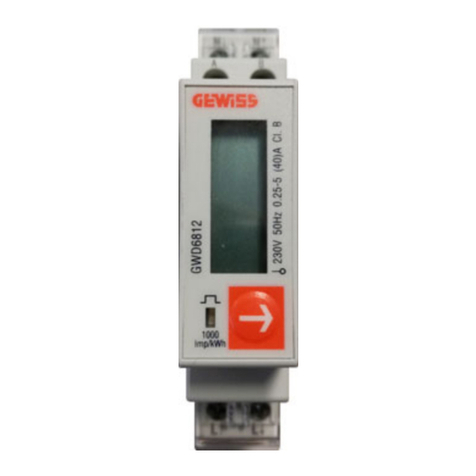
8
Bit-7 Bit-6 Bit-5 Bit-4 Bit-3 Bit-2 Bit -1 Bit -0
n.u. n.u. n.u. n.u. With bit at 1:
Consumed
active energy
With bit at 1:
Produced and
exported
active energy
With bit at 1:
Inductive load
type
With bit at 1:
Capacitive
load type
A few examples to explain the coding:
Decimal value 9, in binary 00001001: means that the system is consuming active energy and the
load is a capacitive type.
Decimal value 10, in binary 00001010: means that the system is consuming active energy and the
load is an inductive type.
5.1.7 Active energy counter reset
This communication object is used to reset the active energy meters via value 1.
The KNX interface performs a command a few minutes after receiving, this is because the GWD6801
periodically checks the status of this command.
During the period that passes between receiving the command and resetting, the object responds with a 1 in
the case of a read request, which is then returned to 0 after resetting is complete.
The enabled flags are C (communication), R (reading from BUS), W (writing from BUS) and T (transmission).
The standard format of the object is 1.003 DPT_Enable, the size of the object is equal to 1 bit.
5.1.8 Generic warning bit
This communication object transmits an alarm on the BUS with value 1 if there is one or more alarms in
objects 65, 66 and 67; when the alarm stops, the value of this object is reset and is sent automatically on the
BUS.
The enabled flags are C (communication), R (reading from BUS), T (transmission).
The standard format of the object is 1.005 DPT_Alarm, the size of the object is equal to 1 bit.
5.1.9 IR port warning bit
This communication object transmits an alarm on the BUS with the value of 1 of no communication via the IR
port with the GWD6801 meter, when the timeout set in the interface parameters expires; when the alarm
stops, the value of this object is reset and is automatically transmitted on the BUS.
The enabled flags are C (communication), R (reading from BUS), T (transmission).
The standard format of the object is 1.005 DPT_Alarm, the size of the object is equal to 1 bit.
5.1.10 Product ID
This communication object transmits the product ID on the BUS in the case of a read request in a character
string of 14 Bytes composed as follows:
2 Bytes used for the character “
4 Bytes used for the hardware and software version
8 Bytes used for the instrument serial number, i.e. the GWD6801 meter
An example for explaining the coding:
Value received from the 14 Byte object: “13157H7F0012”
o2 Bytes for characters “ ”
o4 Bytes for characters 1315 (HW version 1.3 and SW version 1.5)
o8 Bytes for the characters 7H7F0012 (serial number of the connected instrument)
The enabled flags are C (communication), R (reading from BUS), T (transmission).
The standard format of the object is 16.000 DPT_ Character String (ASCII), the size of the object is equal to 14
Bytes.
Cod. 7.01.6.704.4




























